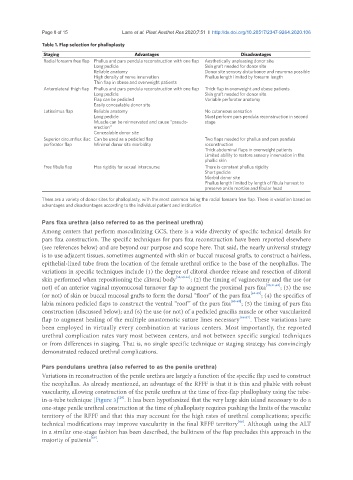Page 592 - Read Online
P. 592
Page 8 of 15 Lane et al. Plast Aesthet Res 2020;7:51 I http://dx.doi.org/10.20517/2347-9264.2020.106
Table 1. Flap selection for phalloplasty
Staging Advantages Disadvantages
Radial forearm free flap Phallus and pars pendula reconstruction with one flap Aesthetically unpleasing donor site
Long pedicle Skin graft needed for donor site
Reliable anatomy Donor site sensory disturbance and neuroma possible
High density of nerve innervation Phallus length limited by forearm length
Thin flap in obese and overweight patients
Anterolateral thigh flap Phallus and pars pendula reconstruction with one flap Thick flap in overweight and obese patients
Long pedicle Skin graft needed for donor site
Flap can be pedicled Variable perforator anatomy
Easily concealable donor site
Latissimus flap Reliable anatomy No cutaneous sensation
Long pedicle Must perform pars pendula reconstruction in second
Muscle can be reinnervated and cause “pseudo- stage
erection”
Concealable donor site
Superior circumflex iliac Can be used as a pedicled flap Two flaps needed for phallus and pars pendula
perforator flap Minimal donor site morbidity reconstruction
Thick abdominal flaps in overweight patients
Limited ability to restore sensory innervation in the
phallic skin
Free fibula flap Has rigidity for sexual intercourse There is constant phallus rigidity
Short pedicle
Morbid donor site
Phallus length limited by length of fibula harvest to
preserve ankle mortise and fibular head
There are a variety of donor sites for phalloplasty, with the most common being the radial forearm free flap. There is variation based on
advantages and disadvantages according to the individual patient and institution
Pars fixa urethra (also referred to as the perineal urethra)
Among centers that perform masculinizing GCS, there is a wide diversity of specific technical details for
pars fixa construction. The specific techniques for pars fixa reconstruction have been reported elsewhere
(see references below) and are beyond our purpose and scope here. That said, the nearly universal strategy
is to use adjacent tissues, sometimes augmented with skin or buccal mucosal grafts, to construct a hairless,
epithelial-lined tube from the location of the female urethral orifice to the base of the neophallus. The
variations in specific techniques include (1) the degree of clitoral chordee release and resection of clitoral
skin performed when repositioning the clitoral body [38,59-61] ; (2) the timing of vaginectomy and the use (or
not) of an anterior vaginal myomucosal turnover flap to augment the proximal pars fixa [20,21,62] ; (3) the use
(or not) of skin or buccal mucosal grafts to form the dorsal “floor” of the pars fixa [61-65] ; (4) the specifics of
labia minora pedicled flaps to construct the ventral “roof” of the pars fixa [60-65] ; (5) the timing of pars fixa
construction (discussed below); and (6) the use (or not) of a pedicled gracilis muscle or other vascularized
flap to augment healing of the multiple anastomotic suture lines necessary [66,67] . These variations have
been employed in virtually every combination at various centers. Most importantly, the reported
urethral complication rates vary most between centers, and not between specific surgical techniques
or from differences in staging. That is, no single specific technique or staging strategy has convincingly
demonstrated reduced urethral complications.
Pars pendulans urethra (also referred to as the penile urethra)
Variations in reconstruction of the penile urethra are largely a function of the specific flap used to construct
the neophallus. As already mentioned, an advantage of the RFFF is that it is thin and pliable with robust
vascularity, allowing construction of the penile urethra at the time of free-flap phalloplasty using the tube-
[28]
in-a-tube technique [Figure 3] . It has been hypothesized that the very large skin island necessary to do a
one-stage penile urethral construction at the time of phalloplasty requires pushing the limits of the vascular
territory of the RFFF and that this may account for the high rates of urethral complications; specific
[68]
technical modifications may improve vascularity in the final RFFF territory . Although using the ALT
in a similar one-stage fashion has been described, the bulkiness of the flap precludes this approach in the
[69]
majority of patients .

